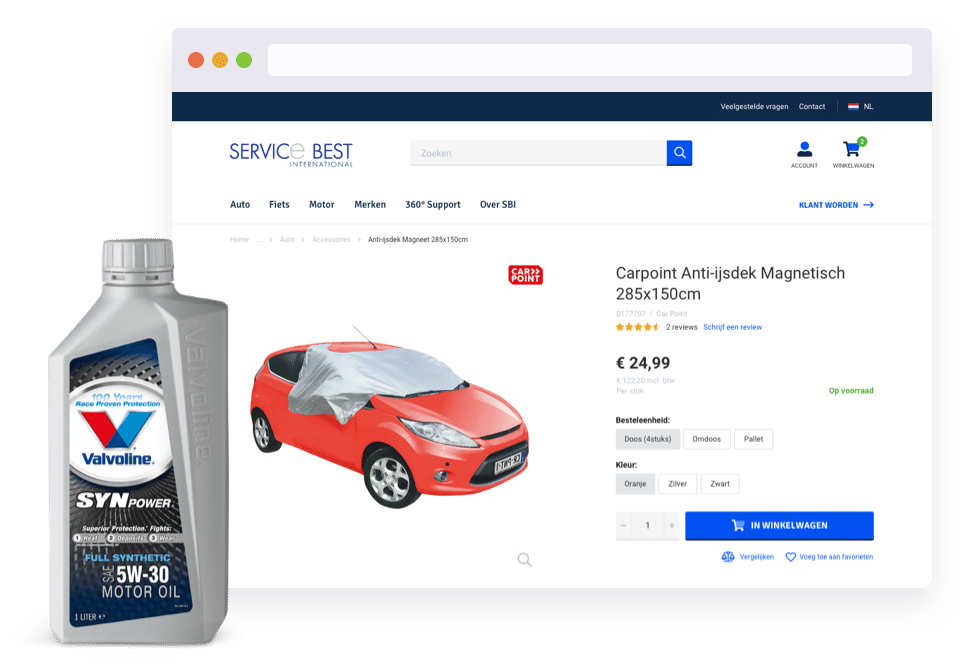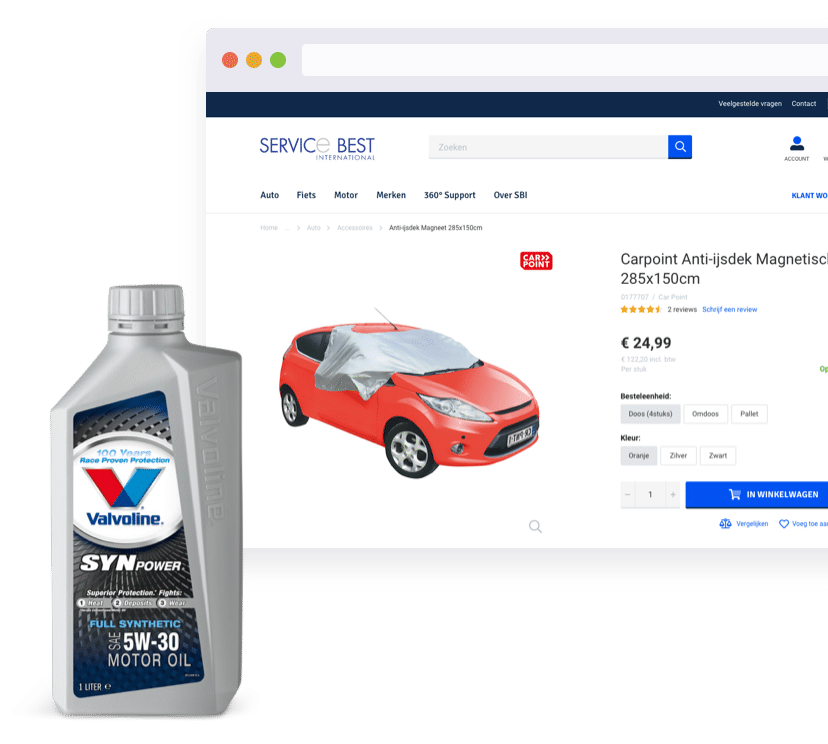What is B2B Commerce?
B2B Commerce, also known as B2B e-commerce or business-to-business electronic commerce, concerns all digital order transactions between companies. It doesn’t matter if the orders happen online or offline. Many organizations in the B2B segment are still struggeling with digitizing their sales organization.
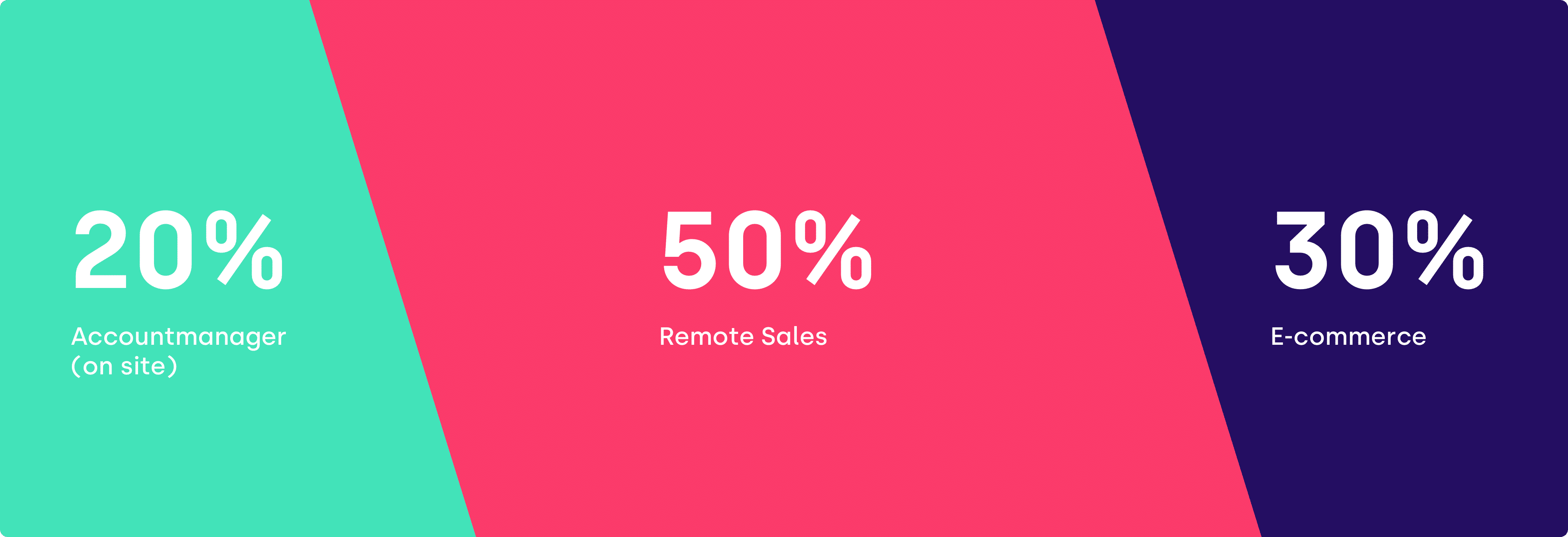
Only 30% of their orders are carried out fully online; the vast majority still go through remote sales or offline through the account manager. Simple orders, in particular, can easily be carried out by the customer himself in a self-service portal. Large and complex orders often still require the knowledge and experience of a sales professional.
Optimize your sales
While online orders often go smoothly – with a few mouse clicks the order ends up in your online shopping basket – the process with offline sales is often less smooth.
Sales teams still work in different systems (Excel, ERPs, CRMs, etc.) and quotations and adjustments are often emailed back and forth to customers several times. Errors – big or small – are constantly possible and the process is certainly not fast and transparent.
Moreover, data from different funnels does not come together, so no overall picture of the customer is available. The information obtained through the sales channel is recorded elsewhere than the information about online sales. This can – and must – be done differently.
With an integrated platform for all your channels, linked to all your relevant systems, you optimize your entire sales process.
Types of B2B e-commerce
There are different types of B2B e-commerce models.
- B2B2C
- Wholesale
- Manufacturing
- Distributors
Without intermediary
First of all, there is B2B2C. Business-to-business-to-consumer (B2B2C) Commerce removes the middleman between the B2B organization and the B2C, bringing businesses directly into contact with consumers.
The wholesaler or manufacturer sends goods to business customers, who then sell the goods to the end user, or by selling directly to the consumer. With B2B2C e-commerce this is done online, for example via a webshop, e-commerce website, app, or directly via social media.
Companies often buy goods in bulk directly from the manufacturer or distributor for a lower price and then sell them at retail value. This is wholesale, a popular type of B2B. This type occurs, for example, in retail, food service, construction and medical sectors.
Traditionally, B2B wholesale transactions took place over the phone, via email, or through spreadsheet order forms. Due to the rise of e-commerce, this is now also happening digitally with the help of a B2B e-commerce platform. The platform enables the wholesaler to list products more easily and creates a seamless buying experience.
Long-term customer relationships
In the same way that wholesalers do their business online, so do manufacturers. B2B buyers are looking for a buying experience that is comparable to B2C and more and more companies can take advantage on this with the digital transformation. Many manufacturers, in turn, partner with distributors, and going digital opens up more opportunities for growth.
As with other B2B models, distributors are working to shorten the lead time of the sales process and optimize the customer experience. A key difference between B2B and B2C is that B2B transactions tend to be larger and more likely to involve long-term relationships with sellers.
One website for B2B and B2C
Many brands think they don’t do B2B Sales, but that is often based on a misconception. B2B, as you have read above, is a variety of things, including wholesale, distribution relationships with large or chain retailers, sales to other organizations (whether corporate or non-profit), and finally suppliers sell to resellers.
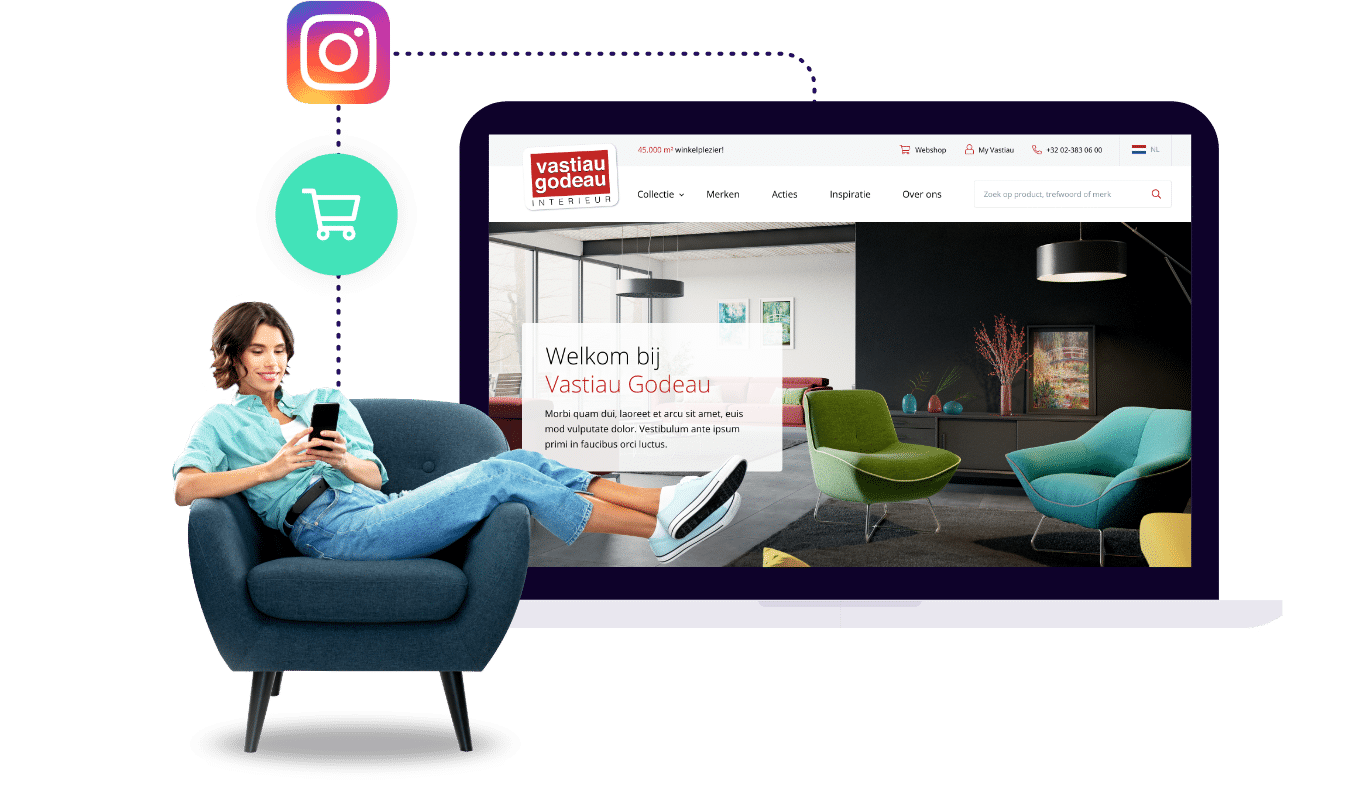
You also don’t need to have a separate e-commerce site to sell B2B. Instead, you can build site engagement and SEO on a single URL that is both B2B and B2C and use customer groups to enable personalized browser experiences for your B2B segment.
Read more about our Propeller Commerce.
What are the main B2B Commerce pitfalls?
Due to the increased online competition, the expectations of customers are increasing and it is becoming more and more important to have a well-functioning B2B webshop. It is essential that you always put the customer first. This sounds simpler than it is. Below we list the most common mistakes made by B2B organizations in this area, so that you can avoid these pitfalls. Linked to this, we give tips on how to make this process as smooth as possible.
Pitfall 1: No integration of the channels
E-commerce is more than just having an webshop. By e-commerce we also mean all resources that contribute to a good performance of the webshop. It is very important to integrate all channels – offline and online – and to join forces.
First determine how you want to spread a message and use different channels. Optimize this for each channel, so that your campaign achieves the maximum result.
Pitfall 2: Bad user experience
A webshop that is often offline, does not work properly or is unnecessarily complicated causes a lot of annoyance among (potential) customers.
A good user experience is essential for customers to actually place an order and then return for more. This not only works for consumer websites, but increasingly also for business online orders. Unfortunately, many companies still think that the user experience for B2B e-commerce is less important than for B2C.
Realize that a bad user experience not only stops customers from making purchases, it also has a bad influence on your visibility in Google. In addition, it is striking that many B2B organizations still opt for an impersonal approach.
However, real-time personalization is important to provide flexibility, personalized content and customer-specific offers. Do not focus purely on conversion on your B2B website, but also provide good information and service. For example, think of relevant content at every stage of the customer journey, filters in the search function and recommendations based on your customer’s browsing behavior.
Correctly applying segmentation and personalization quickly leads to a higher Click-Through-Rate (CTR) and conversion.
Pitfall 3: Not asking for input from the customer
B2B organizations usually still know much too little about their customers. While they usually have a much more sustainable relationship with their customers than B2C entrepreneurs. The relationship is often longer and more frequent. So why not take a look at the wishes and needs of your business customer?
Entrepreneurs think this is time-consuming, but you can partly automate this process. For example, by completing a questionnaire on your website or asking for reviews after purchasing a product. Talk about this at a time that is convenient for both parties, because good follow-up is necessary to help customers better and to maintain trust.
Pitfall 4: No clear requirements document
We often see that B2B organizations do little research before they start with e-commerce. For example, think carefully in advance about which requirements your webshop must meet and draw up a requirements document for this.
Unfortunately, there are many organizations that do not understand the importance of a requirements document, as a result of which they choose the wrong platform or implementation partner. A shame, because often you can avoid having to find out after the launch that you made the wrong choice.
In an extensive document you state your requirements about, for example, the timeline, the functional and technical requirements, the IT architecture, examples as you would like and finally the available budget.
Pitfall 5: Underestimating the effort of the organization
A webshop can give your turnover a huge boost, but to realize this it is important that you set up your organizational structure and your processes properly. In order to grow, a platform needs the right attention. This is often underestimated. Therefore, think carefully in advance about things such as:
- How can automation of your order processing relieve the inside sales and which tasks will your sales team be (more) involved with?
- To which commerce platform do you link your webshop and with which of your core systems do you integrate this platform?
- How do you set up order processing?
- How do you handle your inventory management?
- Who will manage and maintain the webshop?
- How do you set up customer service?
Pitfall 6: Not the right platform
The type of platform that B2B organizations choose is extremely important for the success of their webshop. Unfortunately, choices often turn out badly. That is why it is important to map out in advance what you are looking for. For example, the platform must be stable enough to grow with the organization.
Avoid that your essential systems do not work well with the platform and prevent that your products are difficult to find because the technical SEO is not good. When selecting, it is wise to take the following aspects into account:
- Existing platform or customization?
This choice depends on whether you want to pay license costs for key features in exchange for a lot of functionalities, stability and low maintenance costs, or whether you want to have functionalities developed on a custom platform, which eliminates the license costs. In this case, you need development capacity to keep the platform up-to-date.
- SEO-friendly
Good online visibility in search engines starts with the technical design of the webshop. Components that contribute to a higher position in Google are a filter system that is optimized for SEO, a user-friendly design for mobile and the possibility to provide pages with the correct SEO text and link value.
- Integration possibilities
You can integrate a commerce platform to countless systems. Think carefully in advance about the connections that need to be made (CRM? PIM? ERP? Data Warehouse?) and check which processes you can automate with a commerce platform. For example, if you change a price in the ERP system, this change is automatically implemented in the commerce platform and in the sales channels that you use. This can save a lot of manual actions and time.
- Scalability
Choose a platform that fits the growth objective of your organization. Is your organization growing fast? Then choose a platform that can handle this.
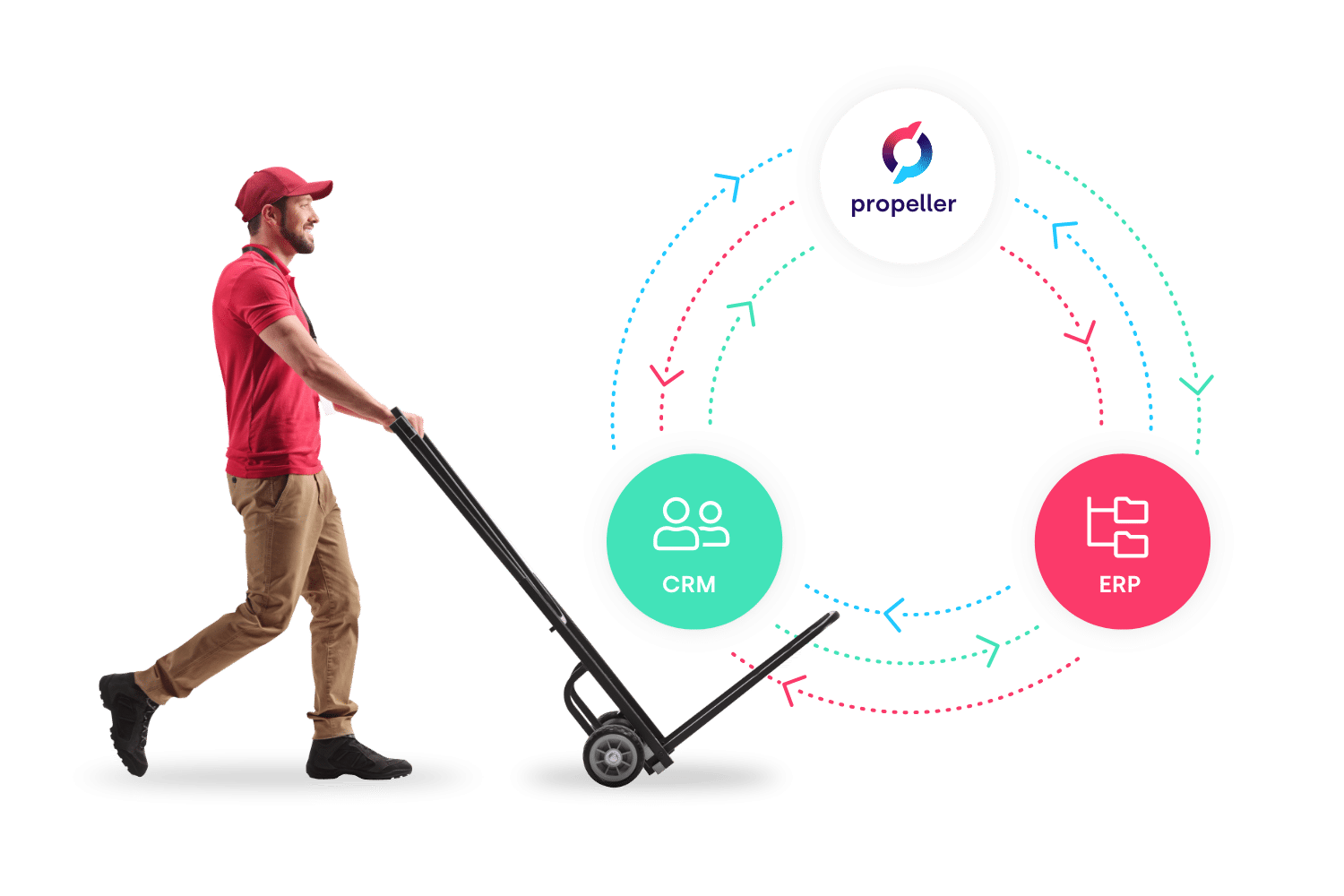
Pitfall 7: Not taking ongoing costs into account
Be aware that a webshop is not a one-time investment. There will also be ongoing costs after going live. The first version of a webshop is usually not 100 percent complete. You continuously have to optimize your webshop based on learnings that you draw from data.
Other additional costs are associated with the hosting of your platform or website and its maintenance. In addition, you can think of online marketing costs for, among other things, search engine optimization (SEO), attracting new online customers through advertisements on Google (SEA) and advertising on social media.
Tip: Start on time
Setting up a good B2B webshop and/or Commerce platform brings a lot of challenges. There are many things to take into account and a lot of choices that have to be made. But if you start thinking about this in time and take the above pitfalls into account, you will be well prepared for the process and you will soon be able to make the right choices effortlessly.
What are the main benefits of a B2B Commerce platform?
More and more B2B customers are ordering online, especially since the outbreak of the corona virus. Still about 70% of purchases are still made offline, either through remote sales or face-to-face. Particularly large and complex orders often go through a sales rep.
Bringing all data about your offline and online sales together in one platform – also known as a B2B Commerce platform – offers enormous advantages, both for the selling party and the buying party.
The main advantages of a B2B all-in-one Commerce platform at a glance::
- Increases your efficiency
- Grow your revenue
- Reduces errors in your ordering process
- Improves your customer relationships
- Improves collaboration between marking & sales
- Future-proof technology
- Maximum freedom of choice in front-ends
- Every customer has its own self-service portal
- Maximum digital support from your sales team
All-in-one future-proof platform
Because all orders are processed digitally in one integrated platform, purchasing efficiency is improved for manufacturers, distributors, wholesalers and other types of B2B sellers. By bringing e-commerce and offline sales together, you generate more sales, reduce the number of errors in the ordering process and improve your customer relationships.
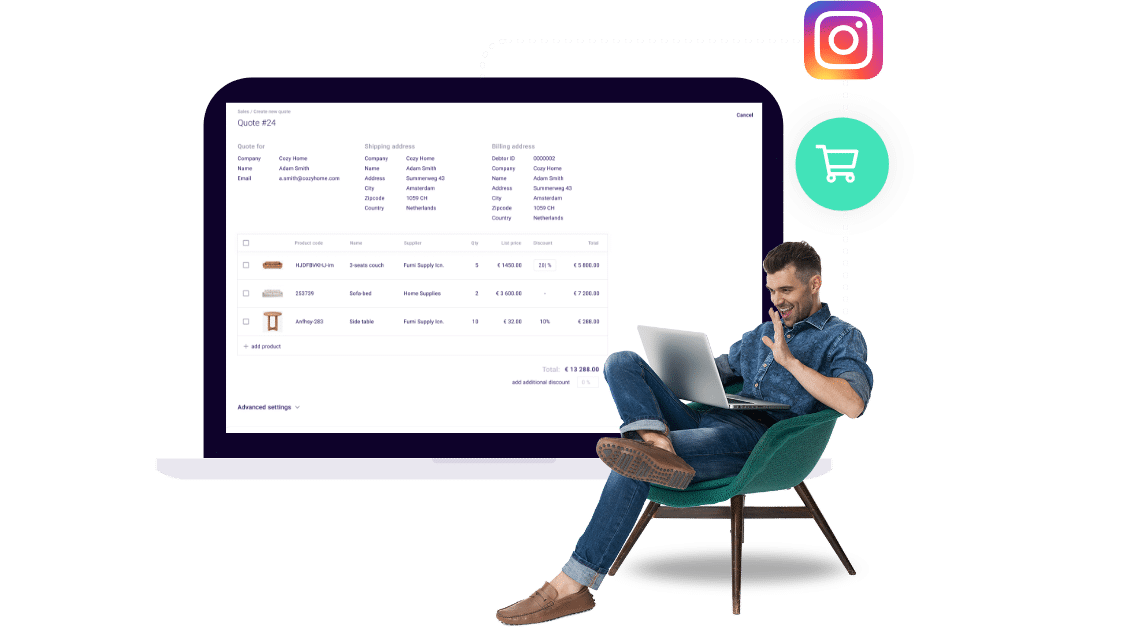
If you digitize all buyer-seller interactions within one platform, you can seamlessly merge your e-commerce and offline sales. Because it is the case that offline deals are regularly partly handled online and that online purchases can have an offline follow-up.
With an advanced Commerce platform that uses state-of-the-art technology, you put your competition behind. Propeller Commerce uses APIs and Microservices. The Cloud-Native platform is also Headless, so you can link any desired CMS to our advanced B2B back-end.
Read more about the technology here.
Webshop, social media or marktplaats
With an integrated platform you go from traffic to revenue, whether you sell via a D2C Webshop, marketplaces or social media. Choose your front-end(s) in your favorite CMS, manage various B2B, D2C and B2C webshops from one back-end. This way you attract more visitors and generate more revenue. Use the best in class lead generation tools and maximize your conversion.
Work with any desired marketplace: Marktplaats.nl, Bol.com, Amazon, or rather a niche marketplace? Or unlock new sales channels on Instagram, Facebook or Snapchat.
B2B Self-service Portal
Customers can place orders in their own ordering environment or customer portal and arrange everything themselves. Here they find their own prices, products, services and invoices in my account. The order procedure is much faster because their order history can also be found here. This way, customers can see at a glance what they have ordered in the past.
In addition, ordering is a lot easier with favorites and order lists. Customers also see their invoices and services purchased, which significantly relieves the office staff and customer care department of B2B organizations.
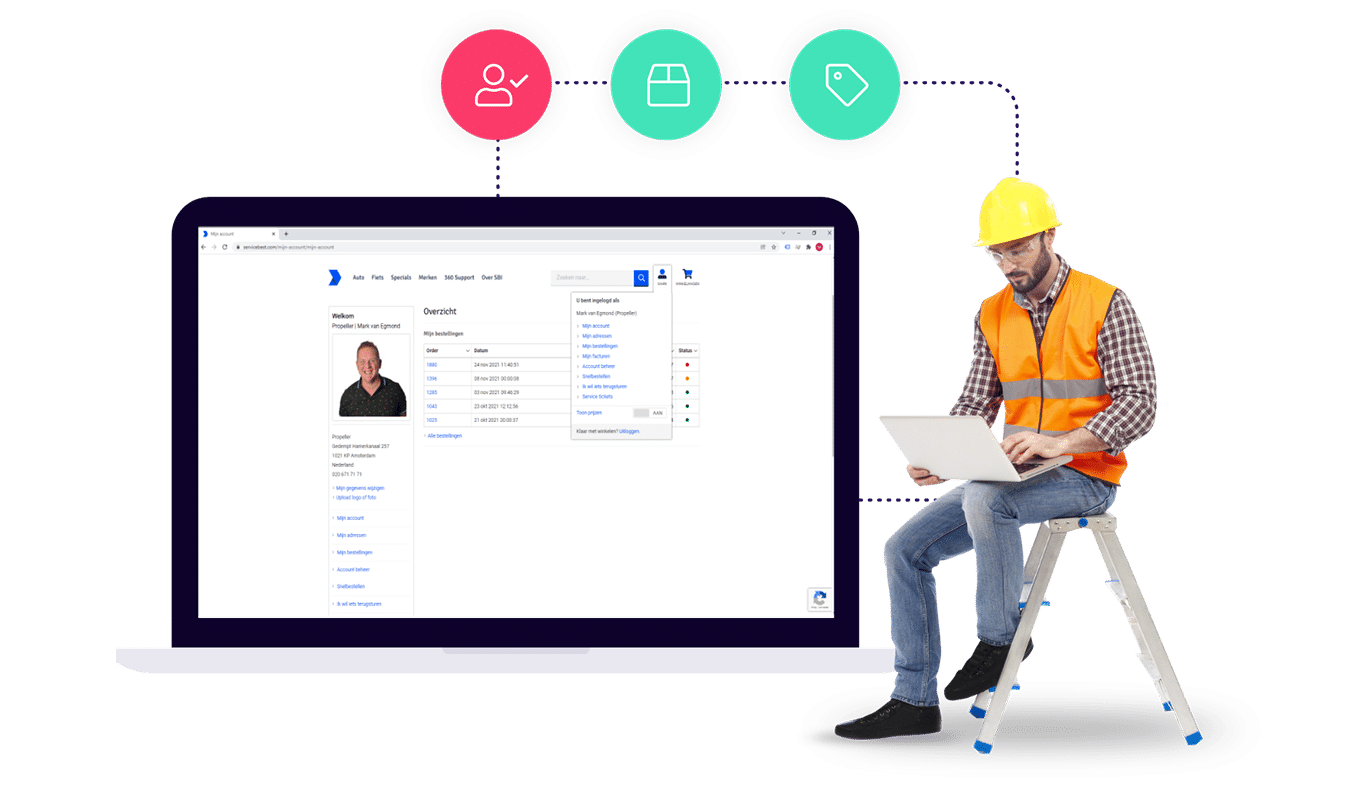
Requesting quotes online has never been so easy: after the request has been made via the webshop, the customer will quickly find the proposal in the customer portal.
Read more about B2B Self-service Portals
Sales Portal (B2B)
With an integrated Commerce platform, you can create quotes faster and easier using digital tools for the sales and services organization. All essential systems can be linked on the platform, so you can leverage all the useful information from your ERP, CRM and PIM system.
In the Sales Portal you can make all information for orders and quotations directly online available for your customers. Of course with intelligent cross- and upsell suggestions. Moreover, you can digitize offline orders in no time. Finally, you digitize the quotation and negotiation process, including manager approval. In the portal, your marketing and sales department and the customer can see all new requests and outstanding quotations.
This way you stay informed of all online and offline orders.
Read more about B2B Sales Portals
What advantages does this offer for my B2B Webshop and B2B website?
With an integrated B2B Commerce platform you not only generate traffic, but you also generate more turnover via your e-commerce website or webshop, via marketplace(s) and/or direct sales channels on social media. Sell nationally or internationally and execute your multi-brand strategy.
Choose the front-ends you want and develop them with your favorite CMS. That can be WordPress, which is often a favorite among online marketers, but another CMS is of course also possible. With a Headless Platform you link any desired front-end to one robust and high-tech back-end.
That way you only need to integrate once with your relevant core systems: CRP, ERP, PIM, your warehouse, you name it.
Tailored to the target group
With an integrated commerce platform, you can develop and design a converting shop for every target group and operate all channels from one commerce back-end. This means that changes only have to be made in one place and are carried out automatically.
You offer every target group the perfect experience using advanced B2B webshop software. Because you can work with your favorite CMS, you optimize your lead generation and branding with the help of integrated tools.
This way you can easily develop and design webshops for specific target groups and also optimize those webshops for conversion, branding and leadgen.
Sell directly on marketplaces and social media
You can also integrate your B2B webshop software with tools such as Channable and Channel Engine. Connect the central Commerce back-end system and sell multi-brand items directly on one or more marketplaces of your choice.
Use custom product templates for each marketplace and be visible on places where your target audience is. Easily increase your turnover via Bol.com, Amazon, Marktplaats.nl or one of the many niche marketplaces.
Multi-channel approach
Finally, with Headless Commerce you can easily create new sales channels on social media. Take part in lead generation and attract customers to your webshop, or sell directly on Instagram, Facebook, Snapchat or one of the other channels.
Using an integration with your Product Information Management (PIM) system, you enrich the product content and publish directly on the all social media channels. By using your favorite content management system (CMS) you optimize your offers per channel.
Read more about B2B Webshops and B2B Websites
What are the advantages of a Headless Platform?
With Headless Commerce you offer your customers the front-end experience they deserve. Experts agree: Headless is the future. With this e-commerce architecture, the front-end is decoupled from the back-end, which provides maximum freedom of choice.
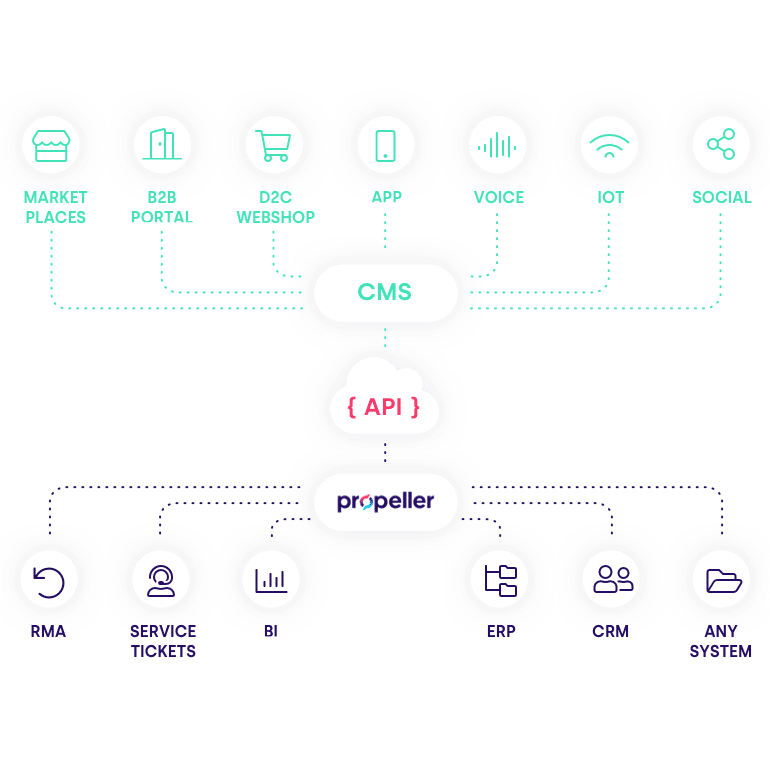
The back-end can be linked to almost any CMS or other sales channel, so that B2B can finally offer a B2C experience to customers. Marketers happy, developers happy. The latter are in fact assured of the best-of-breed back-end platform for all B2B functionalities. Headless Commerce therefore offers the best of both worlds.
The advantages of a headless platform in a nutshell:
- Ultimate flexibility
- Maximum freedom of choice
- Increased conversion rate
- Differentiated shopping experience
Maximum freedom of choice
The biggest advantage of Headless Commerce? Ultimate flexibility. The Headless architecture provides greater freedom of choice and the ability to quickly test new technologies. This way you can quickly find the combination that creates the best possible user experience for every scenario.
To give an example, choose the best front-end solutions, which offers, for example, lightning-fast site speeds or advanced personalizations.
Increase conversion rate
Headless Commerce helps you increase your conversion in two ways:
- Easily create a differentiated and more relevant user experience with your (potential) customers;
- Developing strategies based on content and experience to attract organic traffic and repeating customers.
Differentiated shopping experience
A big advantage of Headless is also the possibility to choose different platforms and technologies that you can combine to merge content and your Commerce platform. This creates differentiated shopping experiences. You can use a CMS like Contentful, Storyblok or WordPress along with your Commerce platform to get the best of both worlds. Prefer a different CMS? No problem.
The headless architecture gives you complete freedom to connect any front-end you want. For example, you can choose to sell directly via Google Shopping, Instagram or Facebook, to apply augmented reality or to develop voice-controlled interfaces.
In this blog you can read when to choose which headless CMS.
How do you make optimal use of Customer Intelligence?
Because advanced Commerce platforms, such as Propeller Commerce, easily link with your relevant systems (CRM, ERP, PIM, etc.) and other external tools and systems, you have relevant customer data. Because you also digitize your offline sales with the B2B Sales Portal and bring them together with your online sales data, you always have all relevant data about your customers.
This way you have all the knowledge, but also the tools, to improve the customer journey.
The benefits of personalization
Know your customers and anticipate on what they need – automatically or personally through your sales team. By emphasizing customer data, you can personalize and improve customer experiences and increase conversion rates, loyalty and reorders. You can use the data and insights for customer-specific sales & marketing campaigns.
Finally, you can combine customer behavioral data on websites with characteristics of your contacts.
B2C-experience in B2B
In 2022, B2B customers expect to get the same rich B2C experience from you as they get at Bol.com or Coolblue. Transactions should therefore be simple, the information sufficient and presented in a pleasant manner. The better the digital experience you offer your B2B customers, the stronger the relationships you build with them. In addition, you benefit from lower costs, additional income and therefore higher profitability.
When you bring all sales activities for your customer together in one customer experience portal, you increase efficiency, increase the chance of after-sales and improve customer satisfaction.
Increase your After Sales
According to research from Forbes, it is 5 times cheaper to keep current customers as loyal customers than to retain new customers. In after sales you already have your customers and they are also qualified customers. Many of the machines and/or other means of production they have bought from you have a lifespan of many years.
This provides a great opportunity to strengthen the relationship with your customers and create more added value for them.
Customer retention and more margin
A digital self-service portal gives shape to your strategy to retain customers and increase your profitability. After sales – including spare parts, maintenance visits, service contracts, technical support, advice, repair, future options and consumables, to name a few – provides manufacturers with many touch points with their customers, while the convenience they offer them lead to higher sales and better margins.
In a customer experience portal, you can view and correct customer information, such as delivery addresses and billing addresses, view quotations, comment on and correct them, so that mailing back and forth about proposals is a thing of the past. The order history, order statuses, (re)order lists, warranty overviews, etc. can also be viewed in the central customer portal.
Marketing automation
When all processes take place in your Commerce platform (including the processing of quotations and other offline requests), you have all relevant data in your platform. Your products, customer information, orders, purchase prices, discounts. All customer specific. You can plot all kinds of marketing activities on this.
For example, you can send automatic messages to extend warranties, anticipate predictable machine lifecycles, and introduce relevant replacement products. Fully automatic and personalized. This way you increase both customer satisfaction and efficiency.
With the help of Customer Intelligence you take the next step in your digital transformation.
Read more about the B2B Sales Portal.
How do you make your marketing and sales departments work together seamlessly?
Until now, your marketing and sales departments often work with their own favorite systems. As a result, customer data remains in silos and there is no overview. With the help of a platform that integrates all data from online and offline sales, supports your marketing and sales departments, and offers maximum flexibility on both the front and back-end, you ensure more turnover, a personalized offer, cross- and upsale and higher customer satisfaction.
And satisfied customers are loyal customers.
Marketing is happy
A platform in which data is central is great for your marketing: all transactions with your customer are centrally available. Ideal for your cross and upselling opportunities. You know when licenses expire and products need to be replaced. Moreover, each quotation can be supplemented with logical extras.
By using integrated email marketing module you automatically send emails with accessories, additional products or replacement options.
Management is happy
A platform in which data is central is also great for management. They can see at a glance whether more or less is being sold to regular customers and how long it takes on average before a quotation is received by the customer. But also how long it takes for this to be approved.
All information is available. By linking with a BI tool, you can compile any desired dashboard.
Sales is happy
When salespeople are processing orders, or answering questions about the sales, delivery, and invoicing process, they are unable to engage in conversations with customers and prospects. By automating such matters and making them available in a self-service portal to the customer, your sales department can focus more on advising, guiding in a purchase or acquiring.
By directly connecting the off- and online sales, you not only save time and reduce the chance of errors, but you also increase the possibility of revenue growth. In addition, employee satisfaction will increase, because adding value is why sales professionals chose the profession!
With less administrative work, they have more time to better serve customers and achieve their targets.
Conclusion
Now that you’ve embraced e-commerce as a B2B organization, it’s time to streamline your entire sales process. The advantages mentioned are obvious. With the Propeller Commerce platform we deliver the necessary functionalities out-of-the box and it is worth making the business case with us.
We would be happy to work with you to calculate what you will save, how much revenue growth you can achieve and what a connected off- and online sales process can mean for your customer satisfaction.
Sales and E-commerce integration at Service Best International
Other customer stories

Digital transformation sales organization PCI

ARAS Security; Digital Self-service Portals




